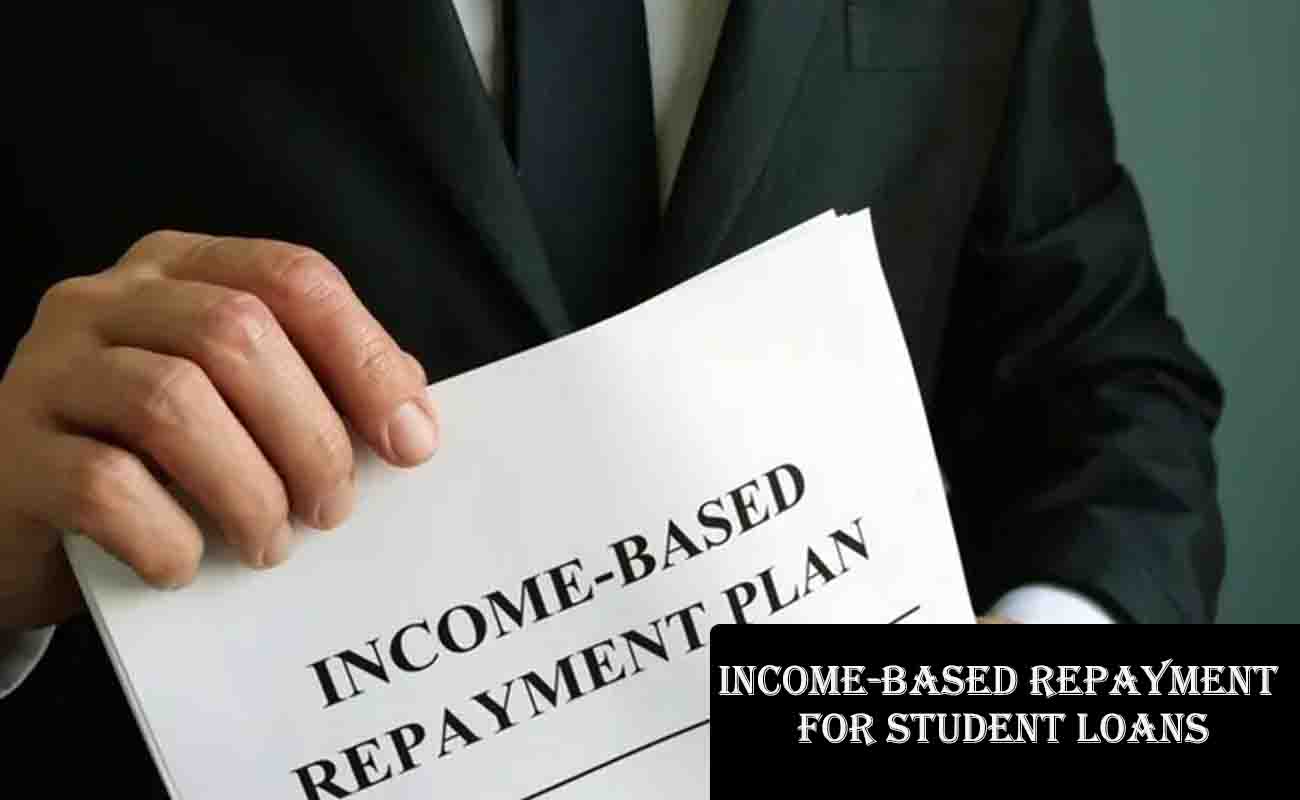In this guide, I will walk You through Income-Based Repayment (IBR) for Student Loans. If you’re like me, you’ve probably spent sleepless nights worrying about student loans. They can feel like a heavy weight, especially when your paycheck doesn’t stretch as far as you’d hoped.

But there’s a solution that might ease your burden: Income-Based Repayment (IBR). In this guide, I’ll walk you through everything you need to know about IBR in simple, everyday language. Whether you’re just out of college or juggling loans years later, I’ll explain how IBR works, who it’s for, and how it can help you manage your debt.
Student loans are a reality for millions of us who’ve chased higher education. They help cover tuition, books, and living expenses, but paying them back can be tough, especially if you’re starting your career or facing financial challenges.
That’s where Income-Based Repayment comes in. It’s a federal program designed to make your loan payments more affordable by tying them to your income and family size. If you’re struggling to keep up or just want a plan that fits your budget, IBR could be a game-changer. Let’s dive into the details so you can decide if it’s right for you.
What is Income-Based Repayment for Student Loans?
Income-Based Repayment (IBR) is a federal student loan repayment plan that adjusts your monthly payments based on your income and family size. Instead of a fixed payment that might strain your budget, IBR calculates your payment as a percentage of your discretionary income.
This means if you’re earning less, your payments are lower, and if your income grows, your payments adjust—but they’ll never exceed what you’d pay under a standard 10-year repayment plan.
Here’s the gist: your discretionary income is your adjusted gross income (AGI) minus 150% of the federal poverty guideline for your family size and state. For example, in 2025, the poverty guideline for a single person in the contiguous U.S. is $15,650, so 150% of that is $23,475.
If your AGI is below this, your payment could be $0. For loans taken out after July 1, 2014, your payment is 10% of your discretionary income; for earlier loans, it’s 15%. This setup makes IBR ideal for borrowers who owe more than they earn, as it keeps payments manageable.
IBR is one of four income-driven repayment plans offered by the federal government, alongside Income-Contingent Repayment (ICR), Pay As You Earn (PAYE), and the newer Saving on a Valuable Education (SAVE) plan (currently under legal review).
What sets IBR apart is its focus on borrowers with partial financial hardship, offering a path to affordable payments and eventual loan forgiveness.
Who is Eligible for IBR?
Not everyone can jump into IBR, so let’s check if you qualify. You need federal student loans, such as Direct Loans (subsidized or unsubsidized) or Federal Family Education Loans (FFEL). Private loans, Parent PLUS loans, or consolidation loans that include Parent PLUS loans don’t qualify.
If your loans are in default, you’ll need to rehabilitate them first, though starting in summer 2025, defaulted loans may become eligible for IBR. You also need to demonstrate “partial financial hardship.” This means your monthly payment under the Standard Repayment Plan (a fixed 10-year plan) must be higher than what IBR would calculate based on your income.
For example, if your standard payment is $400 but IBR calculates $100 based on your income, you qualify. You can check your eligibility using the Loan Simulator on the Federal Student Aid website.
How Are Payments Calculated?
Let’s break down how IBR figures out your monthly payment. It’s based on your discretionary income, which is your AGI (from your tax return) minus 150% of the federal poverty guideline for your family size. Here’s an example for 2025:
- Single person, AGI of $30,000: The poverty guideline is $15,650, so 150% is $23,475. Your discretionary income is $30,000 – $23,475 = $6,525.
- Payment calculation: For loans after July 1, 2014, your payment is 10% of $6,525, which is $652.50 per year, or about $54 per month. For older loans, it’s 15%, so $979 per year, or about $82 per month.
Here’s a table showing sample IBR payments for 2024 (for loans after July 1, 2014, at 10% of discretionary income):
| AGI | Family Size 1 | Family Size 2 | Family Size 3 | Family Size 4 |
|---|---|---|---|---|
| $20,000 | $16 | $0 | $0 | $0 |
| $25,000 | $58 | $5 | $0 | $0 |
| $30,000 | $99 | $47 | $0 | $0 |
| $40,000 | $183 | $130 | $78 | $26 |
| $50,000 | $266 | $214 | $161 | $109 |
Source: Debt.org
If your income is below 150% of the poverty guideline, your payment could be $0, acting like an economic hardship deferment for up to three years, then a forbearance. You’ll need to recertify your income annually, and payments adjust as your income or family size changes.
If you forget to recertify, unpaid interest may be added to your loan balance, and your payment could revert to the standard plan amount.
Repayment Period and Forgiveness
With IBR, you’ll make payments for 20 years (for loans after July 1, 2014) or 25 years (for earlier loans). After this period, any remaining loan balance is forgiven. This is a huge relief if you have a large debt that would take decades to pay off under a standard plan.
For example, if you owe $38,375 (the average student loan debt in 2024), your IBR payment might be as low as $58/month with an AGI of $25,000, compared to $436/month under the standard plan.
However, forgiven amounts may be considered taxable income, unless discharged between December 31, 2020, and January 1, 2026, under the American Rescue Plan Act. Starting in 2026, you might owe taxes on the forgiven amount, so it’s wise to plan.
If you work in public service (government or nonprofit), you could qualify for Public Service Loan Forgiveness (PSLF) after 120 qualifying payments (10 years), and this forgiveness is tax-free.
Benefits of IBR
IBR has some serious advantages, especially if you’re feeling the pinch of student loan payments. Here’s why it might be a great fit for you:
- Affordable Payments: Payments are based on your income, so they’re manageable even if you’re earning less. A $0 payment is possible if your income is very low.
- Loan Forgiveness: After 20 or 25 years, any remaining balance is forgiven, which can erase a significant chunk of debt.
- Flexibility: Payments adjust yearly based on your income and family size. If you lose your job or have a child, your payments could drop.
- Public Service Boost: If you work in public service, PSLF can forgive your loans after just 10 years, making IBR even more attractive.
The government also covers unpaid interest on subsidized Stafford loans for the first three years of IBR, which can save you money if your payments don’t cover accruing interest.
Drawbacks of IBR
No plan is perfect, and IBR has some downsides to consider:
- Longer Repayment: Lower payments mean you might pay more interest over 20 or 25 years compared to a 10-year standard plan.
- Taxable Forgiveness: Forgiven amounts may be taxed as income (except for 2020–2026 discharges), which could mean a big tax bill.
- Income Sensitivity: If your income rises, your payments increase, which might not suit your plans if you expect a higher salary.
- Limited to Federal Loans: IBR doesn’t apply to private loans, so you’ll need a separate strategy for those.
Despite these drawbacks, IBR can be a lifesaver for many borrowers, especially those with tight budgets or public service careers.
Comparing IBR to Other Income-Driven Plans
IBR isn’t the only income-driven repayment plan out there. Here’s how it stacks up against others, based on 2025 data:
| Plan Name | Eligible Loans | Payment Calculation | Repayment Period | Notes |
|---|---|---|---|---|
| IBR | Direct Loans, FFEL | 10% or 15% of discretionary income | 20 or 25 years | Payment capped at standard plan amount |
| ICR | Direct Loans, consolidated loans | 20% of discretionary income or 12-year fixed plan | 25 years | More loan types eligible |
| PAYE | Direct Loans (new borrowers post-2007) | 10% of discretionary income | 20 years | Stricter eligibility for new borrowers |
Source: CNBC
The SAVE plan, which offered lower payments, is currently under legal review, so its availability is uncertain. If you’re a newer borrower, PAYE might offer lower payments, but IBR is more widely available for older loans. Use the Loan Simulator to compare plans.
How to Apply for IBR
Applying for IBR is straightforward. Visit StudentAid.gov or contact your loan servicer to apply. You’ll need to provide your AGI, family size, and loan details. The process is free, and you’ll need to recertify your income annually to keep your payments accurate.
As of March 2025, applications for income-driven plans are open again after a brief pause due to legal challenges, so check StudentAid.gov for updates.
FAQs
- How do I know if I qualify for IBR?
You need federal student loans and a partial financial hardship. Use the Loan Simulator to check eligibility. - What if my income changes?
You must recertify your income yearly. Payments adjust based on your new income or family size. - Does IBR hurt my credit score?
As long as you pay on time, IBR won’t harm your credit. It might help by preventing missed payments. - Can I switch from IBR to another plan?
Yes, you can switch anytime, but check eligibility for the new plan. - What if my loans are in default?
Starting summer 2025, defaulted loans may qualify for IBR, but you might need to rehabilitate them first.
Conclusion
Income-Based Repayment for student loans is a powerful tool to make your payments more affordable by tying them to your income. It’s a fantastic option if you’re struggling financially or have a high debt-to-income ratio.
While it may mean paying more interest over time or facing a tax bill on forgiven amounts, the immediate relief and potential for forgiveness make it worth considering. If IBR sounds like it could help, visit StudentAid.gov to apply and take control of your student loan journey.
